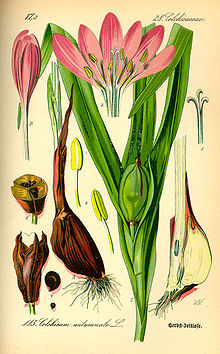Colchicum autumnale
| Colchicum autumnale | |
|---|---|

| |
| Scientific classification | |
| Kingdom: | Plantae |
| Clade: | Tracheophytes |
| Clade: | Angiosperms |
| Clade: | Monocots |
| Order: | Liliales |
| Family: | Colchicaceae |
| Genus: | Colchicum |
| Species: | C. autumnale
|
| Binomial name | |
| Colchicum autumnale | |
| Synonyms[2] | |
|
Synonyms list
| |
Colchicum autumnale, commonly known as autumn crocus, meadow saffron,[3] naked boys[4] or naked ladies,[5] is a toxic autumn-blooming flowering plant that resembles the true crocuses, but is a member of the plant family Colchicaceae, unlike the true crocuses, which belong to the family Iridaceae. It is called "naked boys/ladies" because the flowers emerge from the ground long before the leaves appear.[6] Despite the vernacular name of "meadow saffron", this plant is not the source of saffron, which is obtained from the saffron crocus, Crocus sativus – and that plant, too, is sometimes called "autumn crocus".
The species is cultivated as an ornamental in temperate areas, in spite of its toxicity. The cultivar 'Nancy Lindsay' has gained the Royal Horticultural Society's Award of Garden Merit.[7][8]
Description
[edit]This herbaceous perennial has leaves up to 25 cm (10 in) long. The flowers are solitary, 4–7 cm (2–3 in) across, with six tepals and six stamens with orange anthers and three white styles.[9]: 324 At the time of fertilisation, the ovary is below ground.[10]
Distribution and habitat
[edit]C. autumnale is the only species of its family native to Great Britain and Ireland,[11][10] with notable populations under the stewardship of the County Wildlife Trusts. It also occurs across mainland Europe from Portugal to Ukraine, and is reportedly naturalised in Sweden, European Russia, and New Zealand.[2] It grows in lowland grassy meadows.[12]
Pharmaceutical uses
[edit]The bulb-like corms of C. autumnale contain colchicine, a useful drug with a narrow therapeutic index. Colchicine is approved in many countries for the treatment of gout and familial Mediterranean fever. Colchicine is also used in plant breeding to produce polyploid strains.[citation needed]
Toxicity
[edit]Colchicum is lethally toxic due to its colchicine content and the leaves have been mistaken by foragers for those of Allium ursinum (ramsons or wild garlic), which they vaguely resemble.[13][14]
This plant (and colchicine itself) poses a particular threat to felines. The corms of meadow saffron contain the highest level of toxins, but all parts of the plant are regarded as poisonous.[citation needed]
Gallery
[edit]-
Seed capsules
-
Seeds
-
Detail of flower at the United States Botanic Gardens
-
In a meadow Lauterbourg, (Alsace), France
-
Colchicum autumnale by Auguste Faguet
-
From The Book of Health, 1898, by Henry Munson Lyman
References
[edit]- ^ Linnaeus, Carl von. 1753. Species Plantarum 1: 341, Colchicum autumnale
- ^ a b Kew World Checklist of Selected Plant Families, Colchicum autumnale
- ^ BSBI List 2007 (xls). Botanical Society of Britain and Ireland. Archived from the original (xls) on 2015-06-26. Retrieved 2014-10-17.
- ^ "Colchicums".
- ^ A R Clapham, T G Tutin and E F Warburg, Flora of the British Isles, second edition, 1962, p 982
- ^ Gajic. 1977. Glasnik prirodnaučkog museja u Beogradu, Serija B, Bioloake nauke Nauke 32: 8. Colchicum autumnale
- ^ "RHS Plantfinder - Colchicum autumnale 'Nancy Lindsay'". Retrieved 12 January 2018.
- ^ "AGM Plants - Ornamental" (PDF). Royal Horticultural Society. July 2017. p. 22. Retrieved 24 January 2018.
- ^ Blamey, M.; Fitter, R.; Fitter, A (2003). Wild flowers of Britain and Ireland: The Complete Guide to the British and Irish Flora. London: A & C Black. ISBN 978-1408179505.
- ^ a b Parnell, J. and Curtis, T. 2012. Webb's An Irish Flora. Cork University Press. ISBN 978-185918-4783
- ^ Clive Stace, New Flora of the British Isles 3rd edition 1991, p 855
- ^ "Colchicum autumnale - Burke Herbarium Image Collection". burkeherbarium.org. Retrieved 2023-07-27.
- ^ "Podlesek usoden za dve osebi". 24ur.com. April 6, 2018. Retrieved April 6, 2018.
- ^ Rousseau G, Clément J, Fezard JB, Laribi S (2022). "Intoxication au colchique par confusion avec l'ail des ours" [Colchicum poisoning by confusion with wild garlic (Allium ursinum)]. Rev Med Interne (in French). 43 (9): 559–561. doi:10.1016/j.revmed.2022.04.022. PMID 35597736.
Further reading
[edit]- Autumn Bulbs by Roy Leeds (B.T. Batsford Ltd) 2006 ISBN 0-7134-8962-6
- Brvar, Miran; Ploj, Tom; Kozelj, Gordana; Mozina, Martin; Noc, Marko; Bunc, Matjaz (2004). "Case report: fatal poisoning with Colchicum autumnale". Critical Care. 8 (1): R56–9. doi:10.1186/cc2427. PMC 420069. PMID 14975056.
- Colchicum
- Flora of Europe
- Medicinal plants of Europe
- Flora of Croatia
- Flora of Germany
- Flora of Greece
- Flora of Ireland
- Flora of Italy
- Flora of Latvia
- Flora of Poland
- Flora of Romania
- Flora of Spain
- Flora of Switzerland
- Flora of Ukraine
- Flora of the United Kingdom
- Plants described in 1753
- Taxa named by Carl Linnaeus






